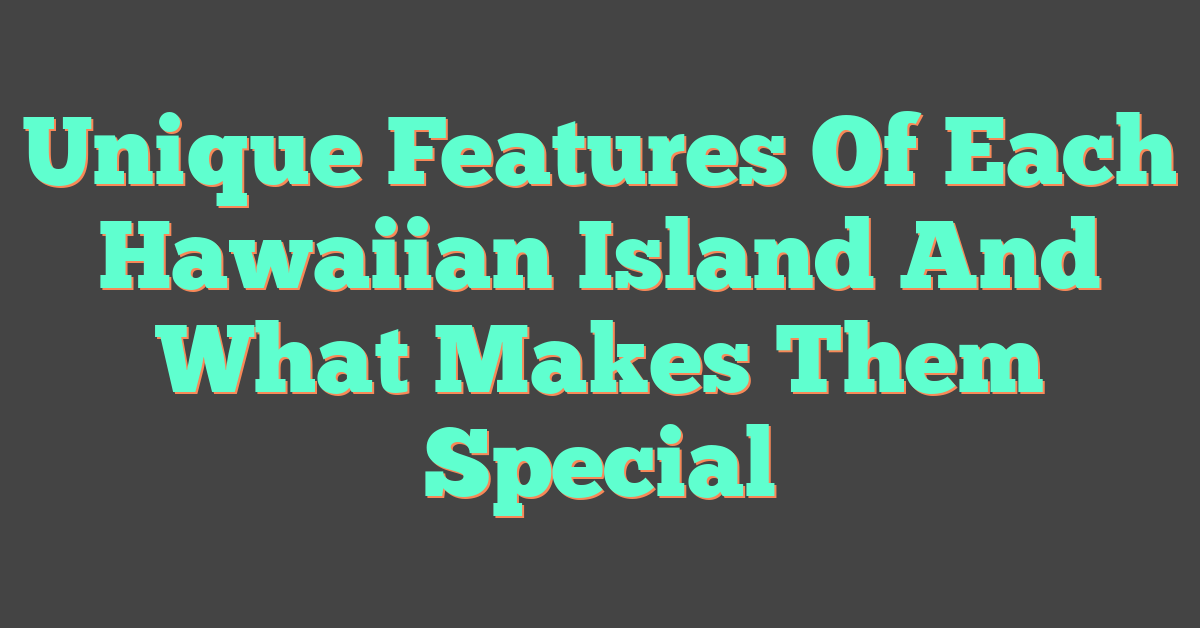Each Hawaiian Island offers its own pace, scenery, and culture. Some islands feature bustling city life and famous surf breaks, while others have quiet beaches, rural towns, and untouched landscapes.

Choosing the right island depends on the kind of experience you want. Each one has distinct features that set it apart.

Oahu offers vibrant energy, legendary waves, and nightlife. Maui combines luxury resorts and scenic drives.
Kauai attracts those who love rugged cliffs and lush valleys. The Big Island gives visitors diverse climates, active volcanoes, and peaceful small towns.
Even the less-visited islands like Molokai and Lanai have unique charms. These islands move at a slower pace and have close-knit communities.
Exploring each island’s special qualities helps travelers find the landscapes, activities, and atmosphere that suit them best.
What Makes Each Hawaiian Island Unique

Hawaiʻi’s islands each developed a unique look, feel, and way of life because of differences in geology, climate, and history. Visitors can see active volcanoes, explore rare ecosystems, and experience traditions that connect people to the land and sea.
Volcanic Origins and Landscapes
Volcanic activity in the middle of the Pacific Ocean formed the Hawaiian Islands. Each island sits at a different stage in its volcanic life cycle.
On the Big Island, Kīlauea and Mauna Loa remain active and create new land with dramatic lava flows. Kauai, the oldest major island, has deeply eroded cliffs like those along the Nā Pali Coast.
Maui’s Haleakalā Crater rises 10,000 feet above sea level and offers sweeping views. Oʻahu’s Diamond Head, an extinct volcanic cone, draws hikers to its popular trail.
These landscapes influence local weather, plant life, and the layout of communities. For more details on terrain, see the unique features of each Hawaiian island.
Ecological Diversity Across the Islands
Hawaiʻi contains many habitats, from coastal beaches to high mountain forests. Many native species live only in Hawaii.
Kauai’s rainforests shelter rare birds like the ʻiʻiwi. The slopes of Mauna Kea on the Big Island support alpine ecosystems.
Oʻahu blends urban areas with green valleys like Mānoa, known for lush plants and waterfalls. Maui’s dry lowlands and wet highlands create a variety of plants and wildlife.
Coral reefs surround every island, providing homes for tropical fish and sea turtles. Hawaii’s remote location has preserved its biodiversity but also leaves it vulnerable to invasive species.
Cultural Traditions and Hawaiian Language
Cultural practices play a strong role in daily life across the islands. Hawaiian language, or ʻŌlelo Hawaiʻi, appears on street signs, in schools, and at public events.
Hula dancing tells stories through movement and chant, often with traditional instruments like the pahu drum. Festivals and gatherings help keep these traditions alive.
Oʻahu hosts major cultural events such as the Merrie Monarch Festival. Smaller islands like Molokaʻi maintain a slower pace, allowing traditions to thrive.
Learning basic Hawaiian words can enrich a visitor’s experience and strengthen their connection to the islands.
Signature Features of Oahu

Oahu combines a busy city center with famous beaches, historic sites, and top surfing spots. Visitors can explore cultural landmarks, enjoy outdoor activities, and experience both modern attractions and preserved history.
Urban Life and Honolulu
Honolulu stands as Hawaii’s capital and largest city. It serves as Oahu’s main hub for business, government, and tourism.
The city features shopping centers, museums, and a range of dining options. Areas like Ala Moana Center and Chinatown highlight both modern retail and local culture.
Honolulu includes important cultural sites such as the Iolani Palace and Bishop Museum. Its location makes it easy to reach beaches, hiking trails, and historic districts quickly.
Waikiki Beach and Diamond Head
Waikiki Beach ranks among the world’s most recognized beaches. Calm waters make it ideal for swimming, beginner surfing, and outrigger canoe rides.
Hotels and restaurants line the beachfront, offering easy access to both sand and city amenities. Sunset views over the Pacific attract many visitors.
At Waikiki’s eastern end, Diamond Head rises as a volcanic crater with a well-known hiking trail. Hikers enjoy panoramic views of Honolulu and the coastline from the summit.
Learn more about Waikiki’s attractions and scenery.
North Shore and Surf Culture
The North Shore is famous for large winter waves and surf competitions. Beaches like Waimea Bay, Sunset Beach, and Banzai Pipeline attract top surfers from around the world.
In summer, the waves shrink, making the area better for swimming and snorkeling. Small towns along the coast, such as Haleiwa, offer local food trucks, surf shops, and art galleries.
Surfing events, like the Vans Triple Crown of Surfing, create a lively atmosphere. Visitors can watch skilled athletes tackle big waves or simply enjoy the relaxed coastal vibe.
Historic Pearl Harbor
Pearl Harbor draws many visitors as a historic site. The 1941 attack here led the United States into World War II.
The USS Arizona Memorial honors those who lost their lives. Visitors can tour the Battleship Missouri and the Pacific Aviation Museum.
Educational exhibits and guided tours explain the events and their impact. For more information, see Oahu’s cultural and historical landmarks.
Distinctive Highlights of Maui
Maui offers scenic drives, volcanic landscapes, and beaches with calm waters and golden sand. Visitors can travel winding coastal roads, see rare alpine plants, and relax on beautiful shorelines.
Scenic Road to Hana
The Road to Hana stretches about 64 miles along Maui’s northeast coast. Drivers navigate over 600 curves and nearly 60 one-lane bridges.
Travelers pass waterfalls like Wailua Falls and pools such as Ohe’o Gulch in Kipahulu. Roadside stands sell fresh fruit and banana bread.
Many stops along the route lead to short hikes, black sand beaches, and scenic viewpoints. The narrow roads and frequent curves make the drive slow, often taking a full day.
Haleakala National Park and Silversword
Haleakala National Park covers more than 30,000 acres with both summit and coastal districts. The summit rises over 10,000 feet, offering sunrise views above the clouds.
The rare Haleakala silversword grows only on the slopes of this dormant volcano. This plant survives in rocky volcanic soil and blooms once in its lifetime.
Visitors can hike trails such as Sliding Sands, which descends into the crater. Higher elevations bring cooler temperatures, so warm clothing is needed even during the day.
Beaches of Kaanapali and Wailea
Kaanapali Beach runs for about three miles along Maui’s west coast. It offers soft sand, clear water, and a paved beach walk connecting resorts, shops, and restaurants.
Snorkeling near Black Rock is popular. Wailea Beach in south Maui features calm surf and wide sandy stretches.
The area has several luxury resorts and a coastal path with ocean views. Both beaches provide public access, restrooms, and nearby dining.
Early mornings often bring the calmest water for swimming. Afternoons can be windier.
Natural Wonders of Kauai and the Big Island
Kauai features lush valleys, dramatic cliffs, and rivers that wind through tropical forests. The Big Island offers volcanic landscapes, rare beaches, and high peaks above the clouds.
Both islands provide striking scenery and outdoor adventures.
Kauai’s Waimea Canyon and Wailua River
Waimea Canyon stretches about 14 miles and drops over 3,000 feet deep. Its colorful cliffs have earned it the nickname “Grand Canyon of the Pacific.”
Visitors can drive to scenic overlooks or hike trails that pass waterfalls and native plants. The Wailua River is one of Hawaii’s few navigable rivers.
Kayakers and boat tours travel past lush banks to Fern Grotto, an area draped in tropical ferns. Nearby Poipu Beach offers calm waters for swimming and snorkeling.
The region’s mix of canyon, river, and coastline gives travelers a variety of landscapes within short driving distances.
| Attraction | Notable Features | Activities |
|---|---|---|
| Waimea Canyon | Deep valleys, colorful cliffs | Hiking, photography |
| Wailua River | Navigable freshwater river | Kayaking, boat tours |
| Poipu Beach | Calm bay, marine life | Swimming, snorkeling |
Big Island’s Volcanoes and Black Sand Beaches
The Big Island features Hawaii Volcanoes National Park. Here, visitors can see two of the world’s most active volcanoes—Kilauea and Mauna Loa.
Trails and drives cross lava fields and craters. You can also see steam vents along the way.
When lava meets the ocean, it cools into volcanic rock and creates black sand beaches like Punaluʻu. Green sea turtles often rest on these shores.
Mauna Kea rises nearly 14,000 feet above sea level. On clear nights, people enjoy some of the best stargazing from its summit.
Cultural and Adventure Experiences
Kauai’s Valley of the Kings preserves ancient taro fields and stone terraces. These features reflect Hawaiian farming traditions.
Guides share the history of the area. They also explain its cultural significance.
On the Big Island, Hilo gives visitors access to Akaka Falls, a 442-foot waterfall surrounded by rainforest. The town features local markets and botanical gardens.
In Kona, visitors tour Kona coffee farms to see how farmers grow, harvest, and roast beans. Adventure seekers can hike, snorkel, or explore coastal lava tubes.
Travelers can explore guides like Unique Features of Each Hawaiian Island or learn about natural wonders of Hawaii.




